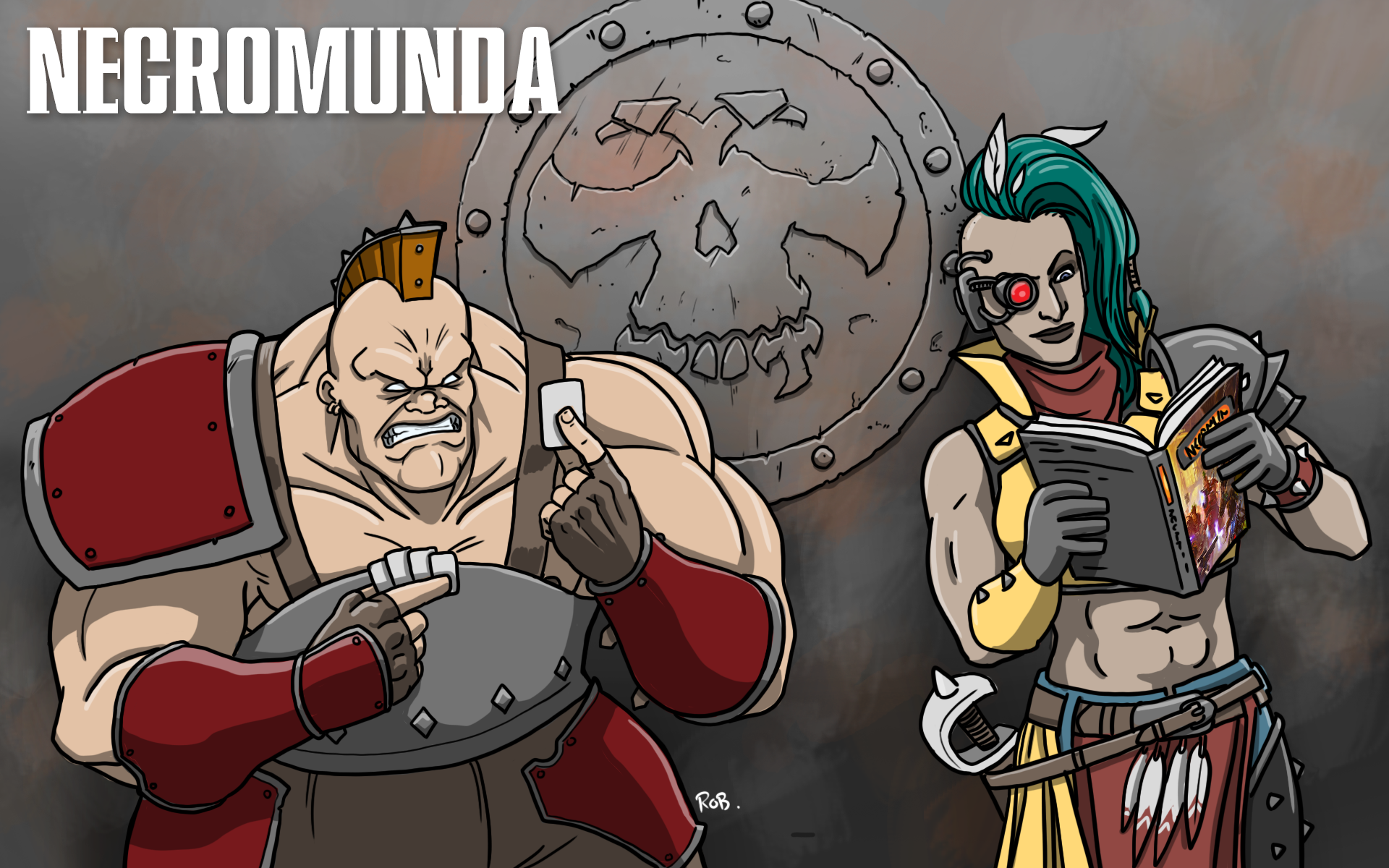Saddle up, scummers! This week, we’re reviewing the smorgasbord of new rules from the various Apocrypha Necromundas — or should that be Apocryphas Necromunda? — that Games Workshop have released over recent months.
From ambot-embedded hereteks to an extremely toxic fan, what do these additions mean for the game?
Games Workshop has put out a bevy of new rules via the Warhammer Community website under the Apocrypha Necromunda banner since August last year. As well as a string of new scenarios, all of them have contained new and exciting rules that can be imported into regular games and campaigns (at your arbitrator’s discretion, naturally).
Here’s the list so far, and what each one contains:
- The Lost Charter (Awakened Ogryn)
- Sump City Sinking (New Spyker powers and Corpse Grinder abilities)
- Twins of Two Tunnels (Gorvos Outcast gangs, new Agitator and Propagandist abilities, new Goliath gene-smithing
- Queen of Ashtown (New Escher Chem-alchemy elixirs)
- Daemons of Meridian (Czarn the Cyberoth Dramatis Personae rules)
- Bullet Road Run (Delaque crews and vehicle equipment lists)
- Blood in the Spire (Spire Black Market items)
- Halfway Dead (Ash Waste Nomad Warrior Spirits)
- Escape from Zalktraa (Palanite Enforcer Enforcement Programs)
- Spiders of the Sump Sea (Sump Sea environment rules)
- Devils of Gunk Deep (Mutant Outcast gangs)
- Hive of Blood (Age of the Gang Kings battles)
- Nexus of Violence (New Cawdor path of faith)
- Feast of Heretics (Corpse Grinder crews and unique vehicle equipment)
- Blood, Ash and Gunshine (Orlock Vehicle Crew Legendary Names & unique Ridge Hauler cargo load)
Important note: these rules are not to be confused with the Apocrypha Necromundus series that landed a few years ago. Unfortunately, there is no way GW could have made this all clearer.
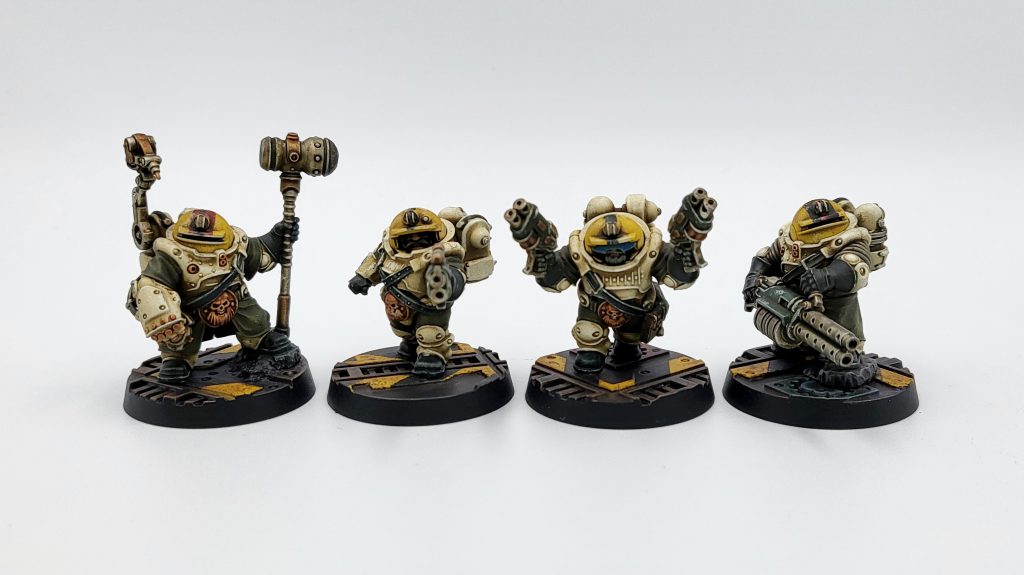
The Lost Charter
Apocrypha Necromunda hit the ground running (on stumpy legs) with an Ironhead Squats vs Ash Wastes Nomads showdown. Neither gang got extra rules, however, with the introduction instead of the Awakened Ogryn — a warp-touched Brute available to all Outlaw gangs except Nomads.
The Awakened Ogryn lands in an interesting spot: Outlaws tend to be pretty limited for regular hanger-on options, but are flush for Brutes thanks to a White Dwarf article from 2020.
Happily, the 220-credit Awakened Ogryn also brings something new: while its competitors are all tanky melee chudds, this is a tanky melee chudd with powers! It is a non-sanctioned psyker and gains access when hired to one of six wyrd powers.
Initially, this looks like an unappealing proposition because the Ogryn has a poor Willpower of 8+. But remember that Brutes can get advances, so you have the potential in a campaign to get more competent — and access the epic array of other wyrd powers.
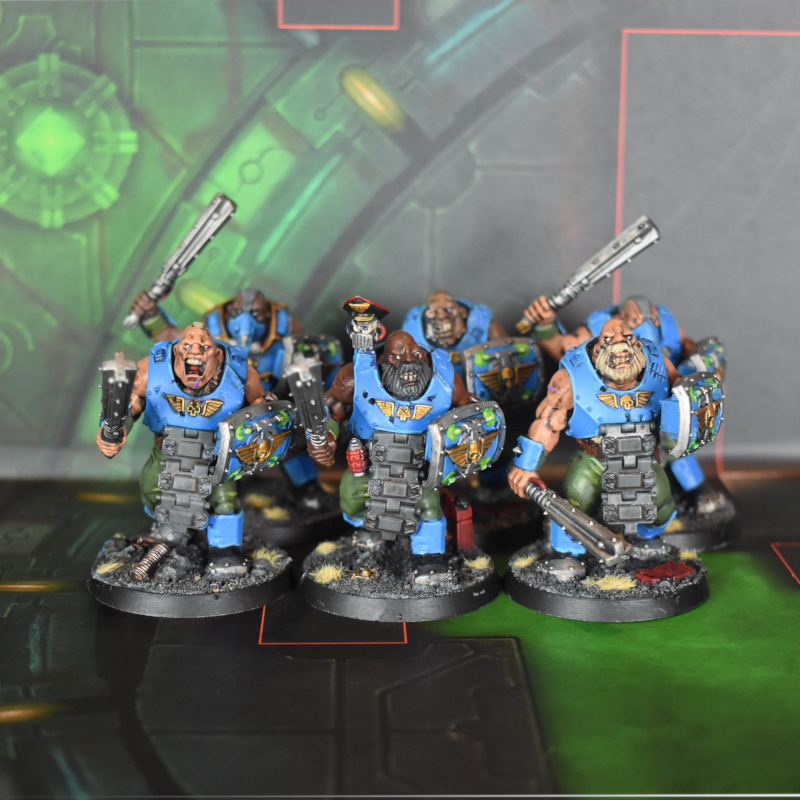
Here’s how the powers look:
- Iron Arm: A 5+ unmodifiable special save with a continuous effect. Decent, although it’s hard to argue a T5 W3 model needs more defence. Rating: C
- Body of Flame: Ignoring hits from Melta and Blaze weapons is great, depending on what your opponent is bringing. The possibility of setting a nearby enemy ablaze is also fun, although it would be an unwise foe who charges a (flaming) ogryn without being sure they can kill it in one go. Rating: B
- Weapon Jinx: A disgustingly good power against almost all gangs. (Simple)! No line of sight needed! Yuck! Rating: A+
- Overcharge: Powers up a ranged weapon. The Awakened Ogryn cannot take any ranged weapons. Why is this here? Rating: F
- Crush: Using your bad willpower AND your bad Ballistic Skill (5+)? Count us out… Rating: D
- Terrify: Solid power, making people run away is good. Rating: B+
Sump City Sinking
Apocrypha two brought Delaque vs Corpse Grinder shenanigans, with new rules for both.
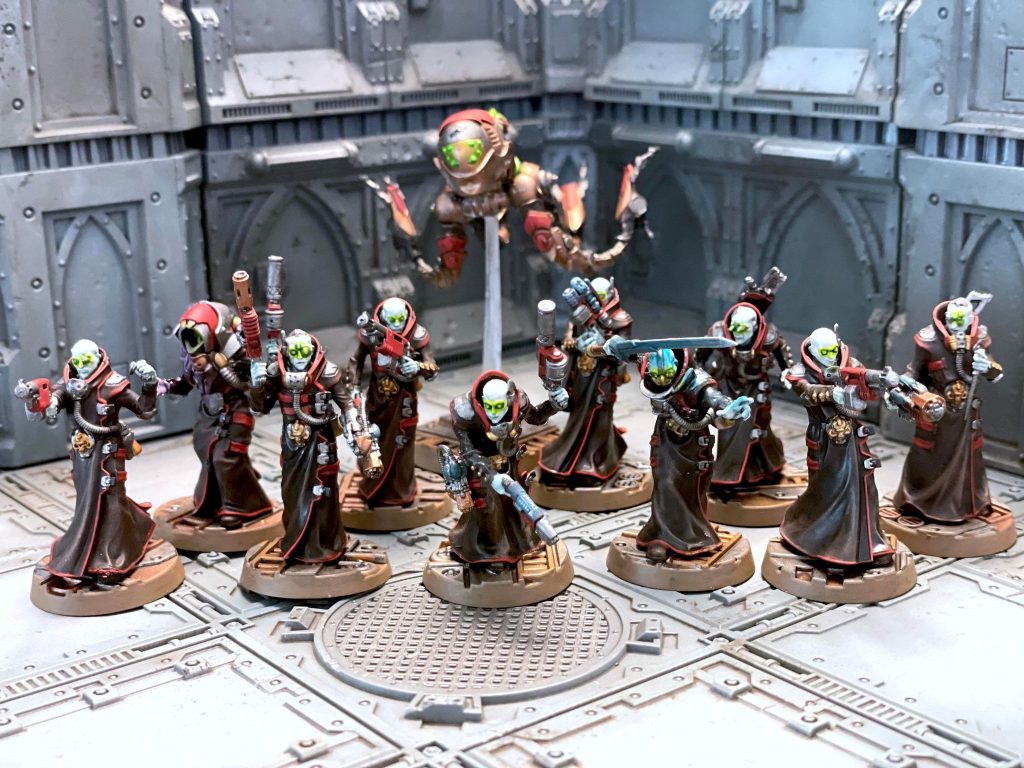
Delaque
Delaque got a new rule called Confluence of Shadows, an alternative set of wyrd powers for Spykers, a House of Shadows hanger-on. Players can choose which one to use pre-game, which is neat as it keeps both options open during a campaign.
Here’s the list:
- Crush: Spykers have the same Crush problem the Awakened Ogryn (above) has: they have dreadful BS (even worse actually, at 6+). Worse still, as they’re hangers-on, they can’t make this situation any better. Rating: F
- Witchfire: This is a cool one, and very hard-hitting, though pulling off a (Double) action while within 3″ of an opponent is going to take some finessed play. Luckily, that’s just what Delaque are good at — maybe Penunbral Mirror has a place here. Rating: B
- Mind Maze: This is the wyrd power equivalent of smearing your enemy in vaseline and watching them try to stand up. It’s not super effective, but it is quite funny — it’s hard to see this get pulled off with much success though. Rating: D
All of these, unfortunately, pale in comparison with Psychic Assault from the regular power list — which is very strong AND lets you keep your fragile brainy buddy behind cover. But it’s a fun list.
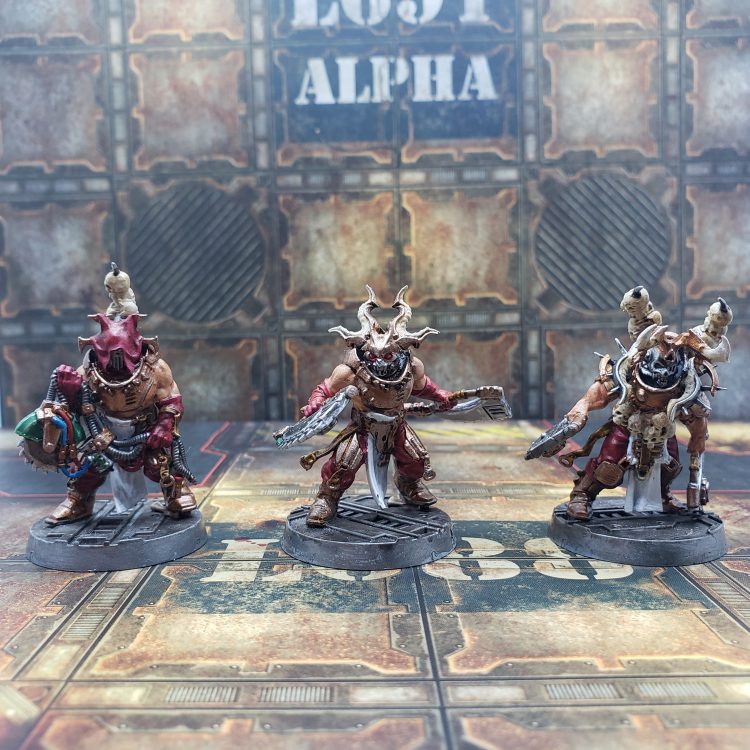
Corpse Grinders
The meaty men (and unrepresented meaty women) get access to Invoke the Dark Gods, a rule that can be invoked when a Gang Hierarchy (X) fighter is activated but before they take any actions.
The fighter makes a Willpower test, with a +3 modifier if they took an enemy Out of Action last go. On a Butcher, this makes their post-kill test a 2+ on 2D6, so we assume/hope groups will remember the “snake eyes is always a failure” rule here.
If they fail, they cop an injury dice roll, while success gives them +1 strength, toughness and attacks this activation, and a 4+ chance to remove a flesh wound or lost wound at the end of the activation. That’s a powerful package — some of the killiest fighters in the game just got killier!
While nothing is guaranteed in Necromunda, BUT the ease of passing these tests after successful kills and their optionality means this is likely to just act as a buff for Butchers and Cutters. It’s not a power boost Corpse Grinders particularly needed, but it could create some flavourful moments.
Twins of Two Tunnels
The third instalment centres on Vunder and Gaen Gorvos, feuding twins introduced in the Book of Judgement. Crunch-wise, we got rules for Gorvos Outcast gangs, new abilities for Propagandists and Agitator hangers-on, and three new gene-smithing options for Goliath. A veritable feast!
Gorvos Gangs
The open-ended Book of Outcast rules were augmented with a new gunky flavour, allowing players to take Gaen ’The Gunk Queen’ Gorvos as their leader, and troublesome brother Vunder as a champion. Gaen’s fixed as a Mastermind archetype (Savant/Cunning primaries), while Vunder gets Survivor (Ferocity/Combat). In addition, all gang members get to take Gunk Bombs for 20 credits — half price!
Neither Gaen nor Vunder are much to write home about on the tabletop (Gaen is worse at fighting than most regular gangers), but the amount of flavour this lot packs is undeniable. A gunk-heavy approach, maybe with some judicious use of flamer weapons, presents a pretty unique fighting style. Just don’t forget that Gaen should want Vunder dead as much as your opponent does…
Propagandists and Agitators
These hangers-on, from Book of Judgement and Book of Ruin respectively, are near-mirrors of one another: both letting gangs earn extra Reputation for betting they will win games, and helping with recruitment from settlements. When they ended up on the board, however, both were (other than having superb models)… underwhelming.
This Apocrypha addressed that slightly: — Propagandists gained the the Rally Allies (Double) action, giving all friendly fighters within 12″ +1 Cool for the rest of the turn — Agitators gains Rile ’em Up (Double), giving friendly fighters within 12″ +1 Movement for the rest of the turn.
Which one of these is better is a moot point because Propagandists are Law-Abiding and Agitators are Outlaw. Add that they’ll only appear on the board quite rarely, and these rules land firmly in the “nice but largely irrelevant” category.
Goliath Gene-smithing
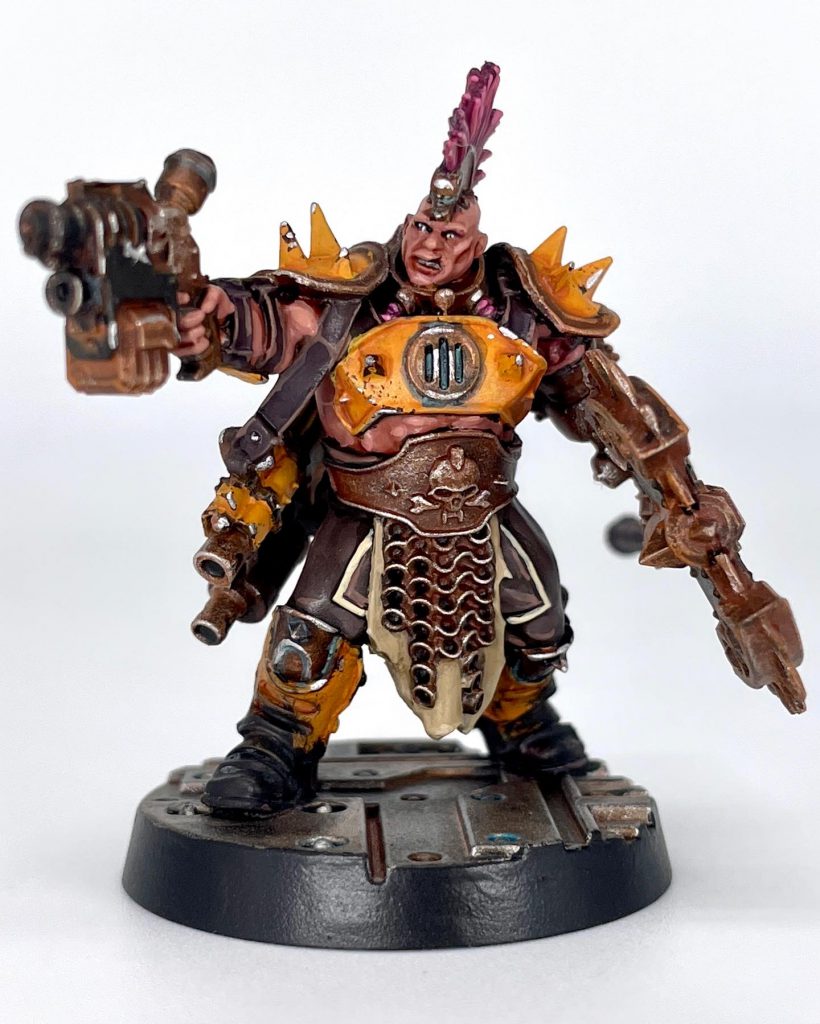
Goliaths got three new genes-smithing options, one for each Sub-type:
- Thermal Resistance (10 creds, Vatborn only): Vanilla Vatborn Goliath with this upgrade reduce the strength of Blaze trait attacks by 1. Against pyromaniac Cawdor, that’ll mean most flame weapons wound on a 6, given Goliaths’ high natural Toughness. In combination with a Hazard Suit, it’s pretty effective — although it’s quite a specialised upgrade. Rating: B
- Enhanced Stamina (20 creds, Natborn only): This upgrade lets n Natborn Goliath treat two-slot (*) weapons as only taking up a single slot. It’s a niche utility, fulfilling a similar role to Book of Peril’s 40-cred suspensor harness, but the prospect of pairing a heavy weapon with a Renderizer on a champion or leader is bound to tempt some muscle enthusiasts. Rating: C
- Unique Organ Transplant (-10 cred, Unborn only): In exchange for a negative cost, Unborn fighters with this upgrade pay an extra D6x10 when taken to the docs. Discounts are always tempting for the ultra-pricy Goliath, so this is tempting offer as long as you’re prepared to let the fighter go if they get critically injured (unless you have a Rogue Doc). Crucially, unlike Unborn fighters’s other cost-reduction options, this doesn’t make the fighter less effective on the board, so we can see it being popular. But scummers: don’t take it when you’re playing a skirmish game just because it means you can ignore the downside. Never be that person. Rating: A
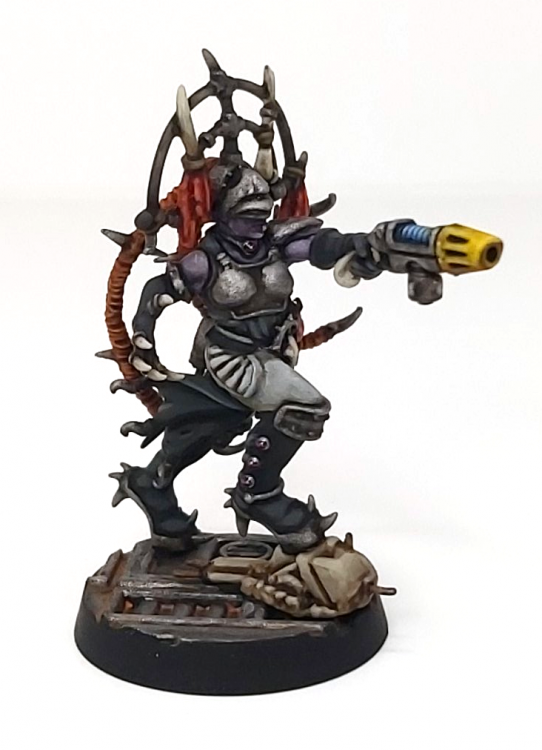
Queen of Ashtown
This Escher vs Goliath showdown brought three new Escher Chem-alchemy Elixirs, each combining a new effect with two older ones:
- Blood Boil (Toxic Ammo, 30 creds): +1 to Toxin rolls, Gas explosions if you kill your target, and potential Insanity if you merely injure them.Maddening and Exploding would cost 25 creds together, so the extra effect here — basically a free Chem-synth — is very good value for money. Hell, you could even then add a Chem-synth. Rating: A
- Skin Fire (Toxic Ammo, 25 creds): The Toxin weapon effectively gains Blaze, targets get a characteristic check debuff and their armour gets worse. This second two are nice bonuses, but the blaze addition is truly tasty. Rating: A
- Predator’s Kiss (Stimm, 45 creds): +1 Strength and Reckless on close-combat attacks, the option to use this stimm to shed a flesh wound or instantly recover from serious injury, and increased movement at the cost of reduced melee hit rolls. This basically puts your fighter in berserker mode, which is undeniably fun, but it’s very expensive and strength is of limited value if you’re leaning hard into Toxin. Since the Strength bonus only applies to the attacks themselves, we think this doesn’t stack with Combat Virtuoso. Rating: B

Daemons of Meridian
A Chaos-versus-Goliath clash added Czarn the Cyberoth — a 220-credit fighter who can be a hired gun for Helot Cult, Outcast and Chaos Corrupted gangs, OR used as an Outcast leader.
Czarn is a bloke installed into an ambot, and comes with all the fripperies that implies: M4, T5, three wounds, a 4+ save and excellent cool. He gets a unique weapon, Warp flamer claws that work as a pretty effectively melee weapon with Paired plus D2, and as a flamethrower with Blaze and Cursed — effectively a Balefire Thrower but with better AP. He has Bull Charge, Crushing Blow and Unstoppable, enhancing his close-combat chops. He also has a unique post- battle action, Automated Repair Systems, that lets him remove Lasting Injuries on a 3+ as a post-battle action.
All for 220 creds! Taken together, this is VERY spicy meat(and metal)ball. Czarn isn’t a bounty hunter, so will leave after one game as a hired gun — making him less attractive — but hoo boy does he look like an effective fighter and Outcast leader. For counts-as enthusiasts, he also provides a great profile to represent a junior daemon prince or some other kind of heavyweight horror.
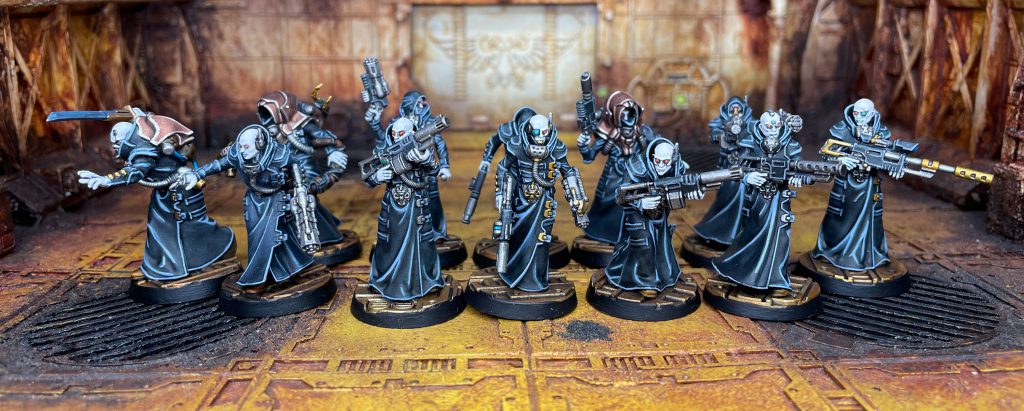
Bullet Road Run
Bullet Road Run introduced Wraiths, a crew fighter for Delaque gangs. This is likely to have provoked mixed feelings for Delaque players who may be wondering why they got a statline but no actual vehicle.
Wraiths are pretty average stat-wise (though superior to Scum Racers), but like Ironhead Squat Gearheads they have Shooting (Primary), which has some nice options for vehicles. They also get an equipment list that includes several baldy favourites — melta, grav, plasma and web guns — all of them pretty excellent. A hipshooting vehicle with a web gun is especially nasty.
Blood in the Spire
The big one. This edition told of a horrific Uphive dinnertime slaughter at Lady Haera’s gaff, and dropped a ton of hard-to-obtain weapons and wargear into the Black Market. Scummers, these items are prestige, so caveat the ratings here with an “…if you can get your hands on it”.
- Archeo Duelling Pistol (Rare 13, 120 creds): A sidearm with 16″ range, +2 to hit within 6″, S5, D2, AP-2, Pulverise AND Rending??? Sign us up! A fighter rocking one or two of these would pack a serious punch while maintaining some serious melee chops. Phwoar. Rating: A
- Barbed Flabellum (Illegal 12, 80 creds): This fancy fan has toxin, AP-2, and a chunky 4″ versatile. And at 80 creds, it’s actually… somewhat reasonably priced? We could see these doing work in the hands of Death Maidens, or even Wreckers (who need those tasty hit bonuses). Rating: B
- Camoelean Elixir (Illegal 10, 75 creds): A fighter can drink this potion as the start of their activation without expending an action, at which point ranged attacks against them are -2 to hit, and melee attacks -1. That is decent enough, but then if they don’t move and don’t have an Unwieldy weapon, they can’t be targeted by any ranged attack from further than 6″ away. Let that sink in, and then consider this: this elixir can stack with a Cameleoline Cloak or a skill like Evade, rendering the user nearly impossible to hit at range without an Improbable Shot. 75 creds is a fair chunk, but on a fighter nestled in a hidey-hole with a Long Rifle, this buys near-invulnerability. Plus, nothing says this item is single-use, so potentially this is invisibility juice you can hit game after game. Arbitrators, take note! Rating: A+
- Digi-multi-lasers (Rare 11, 100 creds): What if meltagun but single shot and melee? It’s the question no one really asked, but here’s the answer. This laser (which has the Digi rule that lets it be used alongside regular close combat attacks) can fire a shot equivalent to a meltagun, before doing nothing for the rest of the game. It has 4″ versatile, which is nice, but at that range the Melta trait won’t proc. Base to base, a +2 hit bonus means you’re really, really likely to hit, wound and instakill all but the tankiest enemies… but for 100 creds you can do much better. Rating: C
- Draconic scales (Illegal 14, 250 creds): Ignore armour save penetration AND negation, but at a hefty cost. This is an ultra-late-campaign, Halo Device-style prestige item from your best fighter once they’re already got a 2+ save, but is just too expensive until then. For lovers of putting eggs in one basket, this definitely has some appeal. Rating: B
- Haemophagic blade (Illegal 13, 150 creds): A mildly more killy stiletto sword for a much-more-than-mild multiple of the price. No. Haemophagic is an interesting new trait but no fighter with 150 creds to blow on a weapon should be looking to stay engaged with an enemy for multiple turns. Consider buying another fancy weapon from this list if you can. Rating: D
- Mirror Aegis (Illegal 12, 125 creds): A 2+ roll to ignore the first time you get hit in a game is likely to be wasted. Unless you know that first hit is going to be a lascannon or a melta weapon, it’s probably too much to pay. Rating: C
- Psychofamile pheromone (Illegal 12, 150 creds): As Corpse Grinders know, forcing enemies to make Willpower checks to attack you is powerful, especially against conviction-lacking Goliaths and Ogryns. The ranged attack defence is almost pointless. Situational and expensive. Rating: C, B against bad-Willpower gangs
- Vortex grenade (Illegal 16, 500 creds): Necromunda’s hardest-to-obtain item is utterly ridiculous: instagibbing any fighter it hits that fails an initiative check, wrecking any vehicle it touches, and then usually hanging around to cause more mayhem, At 500 creds it’s barely worth serious analysis, but if you are rolling in the dough and absolutely need to kill a Ridgehauler, accept no imitations. Otherwise, crack it out in a skirmish game (make sure your opponent gets one too) and just have fun rolling dice. Rating: ???
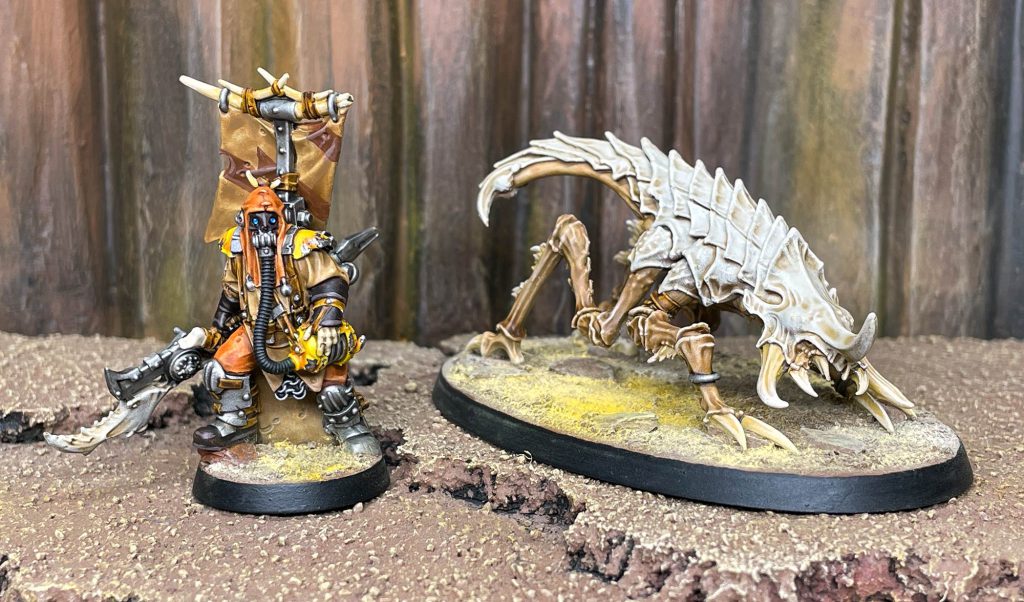
Halfway Dead
An Ashwood Stranger vs Nomads story came with some exciting and unique new rules for Nomads in the shape of Warrior Spirits, giving them an a bunch of interesting new battle options.
Nomads who use these rules — which have no real downside, so we don’t know why you wouldn’t — generate one spirit from a table of six for each Chieftain or Watcher they have. Each spirit can be used once per battle at the start of a Chieftain or Watcher’s activation.
A gang will usually have at least 2, and perhaps 3 or 4 depending on how developed they are. Duplicates can be generated, but can’t be used, which is weird. Still, overall these are a fun, thematic and powerful bunch of additions.
- Styr’ghar (Storm Spirit): If the Visibility (X) rules are in effect, the fighter can teleport to anywhere at least (X) away from enemy fighters. Their activation then ends, which limits this power’s ability as an offensive tool, but its possibilities are still pretty expansive. In combination with a Stormcaller to get Visibility down (obligatory here if you’re playing Nomads “indoors”), we reckon this would allow for some tasty finesse plays. Rating: B+
- Dae’ghar (Chem Spirit): Place a 5″ blast marker under the fighter, which enemies then treat as Dangerous Terrain. Dangerous Terrain is really dangerous! The usage is kinda niche but this makes the fighter super scary to charge for any low-initiative melee attackers, and can be used to temporarily block an attacking path for your enemies will you hot-foot it away. Rating:B
- Tyr’ghar (Ash Spirit): Enemy fighters within 3″ must pass an initiative check or go Blind, losing their ready markers. It’s hard to engineer the type of situation in which this is useful, but at the right moment it could prove clutch. Rating:B
- Char’ghar (Electro Spirit): Dreadful pun name aside, this one is beastly: any Shock attack made during this fighter’s activation automatically wounds. Given the plethora of exciting Shock options Nomads have, that’s very good. Rating:A
- Vau’ghar (Fire Spirit): A fighter within 12″, or the caster, gains 2 Attacks and adds 1 to their Weapon Skill rolls. This is strong stuff, probably best used as part of a group activation with a Dust Rider or Stormcaller who can then hurtle into the fray for a crucial kill, or to soup up a Duneskuttler even more. Rating:A
- Myr’ghar (Blade Spirit): Much like the fire spirit, this makes the fighter killier in melee — although it can only be self-cast. Melee and versatile weapons up to AP-3, and given additional damage. It can be stacked with the fire spirit, but you’d need two fighters working together to pull it off. Again, it’s a no-brainer if you’re planning a crucial charge. Rating:A
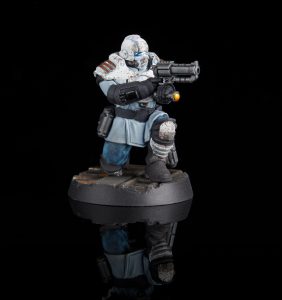
Escape from Zalktraa
A prison-break scenario packed in new rules for Enforcer players in the form of Enforcement Programs, which can be turned on for a player’s Sanctioner brutes and Cyber-mastiffs. Note this is an all-or-nothing decision: either everyone uses it, or nobody does.
If activated, those fighters must then choose a one of six Programs, which can be changed between with a Reboot (Double) action. Each program brings a benefit but restricts the fighter to a pool of only two or three different actions.
Before we get into the actual list, a quick note: these rules, as written, suck, because none of the Available Action lists include Stand Up or a plethora of other core movement actions — meaning it’s basically game over if you get pinned. We’d encourage players and arbitrators to make sensible adjustments, and will be rating these as though such changes are in place: if they are not, these would all be an F.
- Hunt (Move/Shoot/Aim): This program forces the user to slowly creep forward towards the nearest enemy fighter. It allows shooting and aiming, which makes it tempting to push a Sanctioner forward while maximising its ranged capacity. On doggos it’s less appealing — not having access to Charge is a blow, and having to wait a full turn to change into a Program that can charge is stupid. The extra leash length for mastiffs is also usually meh because they’re better off closer to their owners. Rating:B for Sanctioners, D for Cyber-mastiffs
- Intimidate (Move/Charge/Fighter): Grrrrrrr, charge charge bark bark. Forcing enemies within 2″ at the end of your activation to take a Nerve test is solid goodness, even if it won’t always be effective or useful, and this Program lets Cyber-mastiffs do what they do best. We can’t imagine Sanctioners wanting to ditch their shooting abilities to do this, but if you know a charge is coming you could do worse than get your scary face on. Rating:C for Sanctioners, A for Cyber-mastiffs
- Guard (Shoot/Fight/Aim): +1 hit and wound on Reaction Attacks and Got Your Six attacks is very decent on a Sanctioner if you’re bracing for a charge. On dogs, we’d avoid this. Rating:B for Sanctioners, D for Cyber-mastiffs
- Capture (Charge, Fight): 4+ to capture a fighter you take out of action is very good odds if you want them. Unfortunately, it requires a direct Out of Action rather than a Coup De Grace, so will come up pretty rarely. Rating:F for Sanctioners, D for Cyber-mastiffs
- Kill (Charge/Shoot/Fight): Free Fast Shot on your Sanctioner, in exchange for losing the ability to move (except by charging). It should be pretty easy for most opponents to get around this, but in the right situation it could be strong. Rubbish on dogs. Rating:B for Sanctioners, F for Cyber-mastiffs
- Rescue (Move/Fight): Blowing multiple turns of activations just to assist a recovery is a waste of a Sanctioner’s powers, but on a dog that’s only going to play support, this is solid. Bear in mind this means proximity to a Cyber-mastiff grants immunity to Coup De Grace AND guarantees your champion/leader will stand up at the end of their go — that’s not to be a sniffed at (or bitten, or licked.) Rating:F for Sanctioners, A for Cyber-mastiffs
Spiders of the Sump Sea
Yo-ho-ho and a bottle of Wild Snake! This packed Apocrypha brought in new rules for battles upon the Sump Sea, effectively an adapted set of Ash Wastes rules.
Sump Sea Environments effectively act as an override for the battlefield surface (as introduced with the Ash Wastes rules): instead of scorching deserts or ashen plains, it’s some very stinky liquid — the Sump. Nothing says that this precludes regular Battlefield Conditions, although players may want to exercise some discretion here.

These are the key changes:
- Only vehicles with the Waterborne or Skimmer rules can be used.
- Fighters with the Mounted condition are assumed to be on something appropriate (think pedalo or friendly Sump-croc)
- Non-mounted fighters who start their activation in the Sump risk drowning, and end their activation as soon as they touch the Sump
- All fighters in the Sump count as having heavy cover and become immune to regular pinning
- Falling into the Sump doesn’t do any damage.
- If a fighter becomes seriously injured in the Sump, they instead go Out of Action.
Straight out of the (water)gate, there are some interesting choices here. Although the Sump is a malleable concept, the way it is being represented here certainly feels a lot more “Sump deep puddle” than “Sump Sea”. It’s also clearly a big boost for mounted fighters, who basically lose their biggest downside (a propensity to fall off things and get hurt by the “I Get Knocked Down…” rule). Flea/backswimmer-riders, rejoice!
Drowning is obviously going to be a big factor, depending on how your board is set up. It’s a fairly simple mechanic: pass a strength check, and you can move D6″ in any direction. Fail it, and take a flesh wound. Either way, the fighter’s activation ends afterwards. It’s a nasty way to go.
The document introduces two new vehicles, the Sludge Barge and Scrap Skiff, which both have the new Waterborne special rule. Waterborne effectively represents a new kind of locomotion — barges drift D6″ forward when activated, while skiffs move D3.
- The Sludge Barge is 165 creds, and is similar to a Heavy Vehicle, with M6, T7/6/6 and 5 Hull Points. Its weapon choices are fairly vanilla, with the notable exception of Web Gun access.
- The Scrap Skiff is 45 creds, and is roughly equivalent to a Light Vehicle, with M8, T3/3/3 and 1 Hull Point. Their list has grenade launchers, harpoon launchers and heavy stubbers.
Given both can take harpoon launchers, this is as good as any to note that Drag still doesn’t work on vehicles in the new core rulebook. Shame!
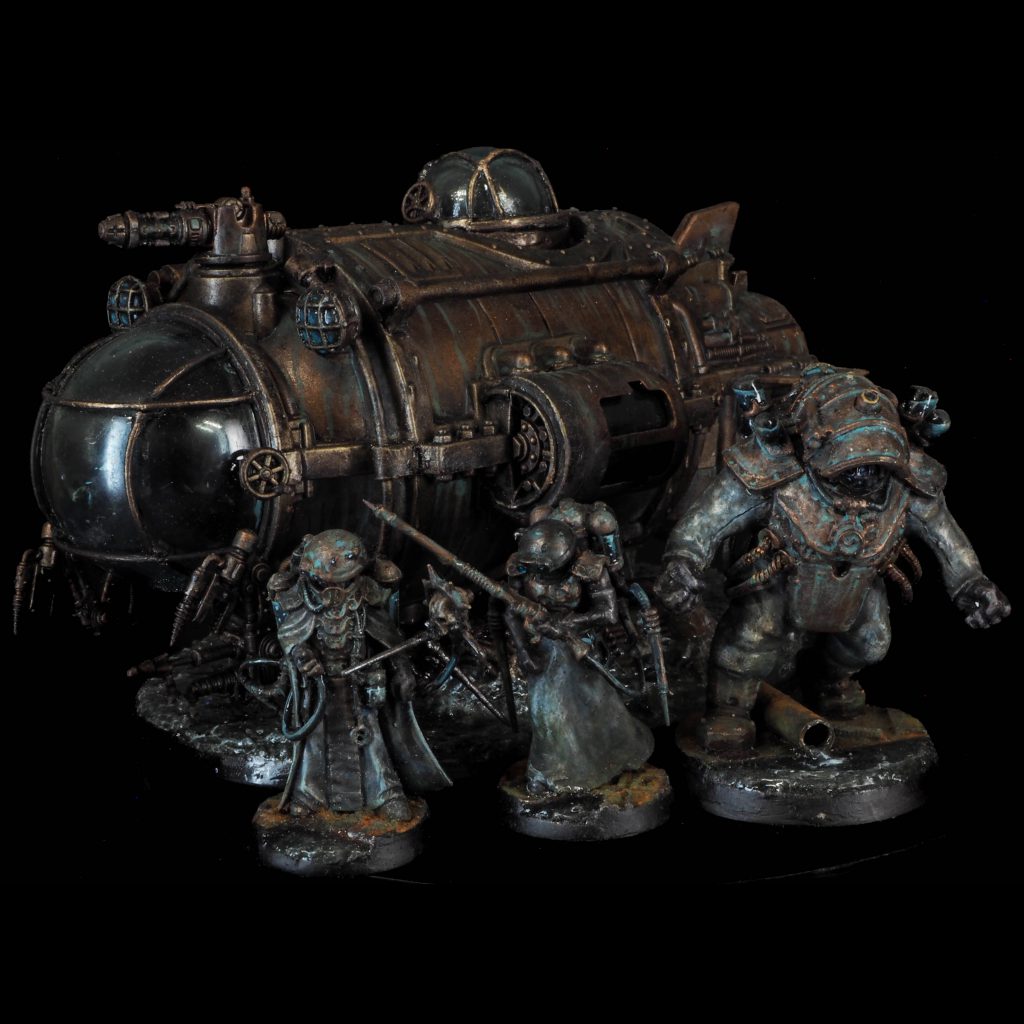
The barge can take a transport bed upgrade, but the skiff cannot — making the latter an even more risky option for transporting troops.
Both vehicles are limited to a select list of upgrades, but have open access to weapons and vehicle wargear from the Trading Post. Ramming looks to be as effective as ever, with the low cost and high movement of Scrap Skiffs — combined with access to glys injectors and booby-trapped fuel tanks — making them tempting kamikaze options.
…and that’s it. Obviously some hydrophilic players are going to be delighted to have rules for their already-built water vehicles, but given the commitment needed to create gangs, terrain and vehicles suitable for this environment, we feel like any scummers seeking a pirate’s life should probably add some more house rules to augment these. Here are some of our initial ideas for what arbitrators could add:
- more nuanced drowning, perhaps involving heavily-armoured fighters being at more risk of sinking under
- blast weapons probably should probably do much lower damage when they hit the Sump, but scatter less
- more vehicle profiles!
Nonetheless, it’s a great starting point and we’re sure some highly-committed group of kitbash fanatics is going to do some amazing things with these rules. Which, after all, is how Necromunda is supposed to work. Now where’s that Arkanaut Ironclad…
Devils of Gunk Deep
Mutants! One of Necromunda’s fan-favourite underclasses, somewhere below the scum but above the cults, get new rules in this Apocrypha — with players given a toolkit to create Outcast gangs with some… unusual… biological features. Just don‘t call them Scavvies…
The integration of the Mutant gang rules is fairly simple. Outcast leaders and champions gain access to a new Archetype, Mutant, which gives them Primary access to Brawn (meh) and Leadership, and Ferocity as a Secondary. It’s mildly interesting that this lets Champions take Leadership skills.
Much more importantly, Mutants can choose new Outcast Mutations. Think of them as basically an expanded skillset — for leaders and champs, they’re gained in the same way as Primary skills, but there’s a much bigger set to draw from.
It gets better. If an Outcast gang leader has the Mutant archetype, then all Outcasts Hive Scum added to the gang can take a single Outcast Mutation when recruited (it also forces the gang to be have the Clanless affiliation, which maximises the variety of hangers-on and brutes they can use). From this perspective, the Mutations act a bit more like Goliath gene-smithing.
So what are the Outcast Mutations? Well, they’re tasty, several are explicitly better than some regular skills, AND most are cheaper than regular skills.
All of these obviously present a fantastic opportunity for modelling and narrative. They also have pretty tasty in-game effects. Here’s our rundown:
- Void Soul (15 creds): Psychic power immunity is still pretty niche despite an increased proliferation within the game, so how useful this is will be depends on who your opponents are. Rating: ???
- Eye Stalks (20 creds): An super-evocative mutation with a decent effect — this could make a fighter already in heavy cover very hard to pick off. 180 degree vision is also pretty useful on a sniper. A bit pricey though. Rating: B
- Extra Appendages (20 creds): 20 creds for an extra attack is a good deal however you look at it, but add in the ability to use three weapon at the same time and this starts to look like a fantastic skill, especially in combination with Two Heads (coming up). Rating: A+
- Horrific Appearance (15 creds): It’s the (decent) Fearsome skill, but cheaper, and a passive effect forcing nearby activating enemies to make Nerve checks. That’s solid, especially against low-Willpower gangs, although not staggeringly strong. Rating: B
- Massive Claws (10 creds): Extra Strength, AP and Rending on unarmed attacks is solid — although you’d want to weigh up the potential benefits of using weapons for extra attacks. Good for a cheap fighter. Rating: B
- Needle Spines (15 creds): Melee hit de-modifiers are solid if you’re getting swarmed by chaff, but are unlikely to stop many of the game’s big melee scaries. The active power is nice, but looks pretty situational. Rating: C+
- Scaly Skin (25 creds): A 4+ save usually costs 40 creds (mesh armour + armoured undersuit). This costs 25 creds. Do the maths. Only the value of Vast Bulk (coming up) stops this getting a higher rating. Rating: A
- Tentacles (10 creds): Re-rolling initiative checks for falling is quite situational, as are parries. It’s slightly odd that this grants unarmed attacks the Parry trait, rather than giving the Parry skill, but in theory (if you can manage to get the Parry skill another way — not an easy task), lets you stack a lot of Parries. Rating: C+
- Toxic Blood (15 creds): In theory, this power is at its best against melee monsters, who unfortunately tend to have decent Initiative. Against certain gangs it could create a serious roadblock though — the killier the attacker, the more danger they put themselves in by mulching a fighter with this mutation. Rating: B
- Two Heads (15 creds): It’s the Gunfighter skill, except your vision arc increases instead of gaining the ability to target two enemies at the same time. This makes no narrative sense to us, but whatever. In general, we think that makes it worse than Gunfighter, but it’s cheaper, and you probably can’t get Gunfighter anyway, so it’s a solid option. Rating: A
- Vast Bulk (10 creds): Probably the best pick on the list and the most open to abuse, +1W is a bargain at this price. Why is it half the cost of other, obviously worse mutations? Nobody knows. Rating: A++
- Wing Membranes (15 creds): The fighter can leap distances up to their Move characteristic without an Initiative check, and never takes damage or goes prone from falling. This is actually a great mobility skill if you play on complex tables, and would well serve some kind of melee or grenade-chucking mutant. It’s also strictly better than the 50-cred grav chute, because you’ll never end up Pinned from falling. Rating: A
What does it all mean? Well, first things first: this is a really powerful list. Almost everything here is worth attention, and over the course of a campaign could let you build up some seriously nasty fighters.
That also means it looks a little open to min-maxing: in particular, a gang packed full of Vast Bulk mutants could be a very scary proposition. We’d encourage players to embrace variety, rather than going down this route, as tempting as a Big Chungus gang might seem. It’s something of a shame that Vast Bulk is there at all, when nearly every other option looks more nuanced and reasonably priced.
The new Mutant archetype also has some potentially interesting interaction with the Book of the Outcast’s rule for elevating gang leaders — which would let you, with arbitrator approval, use any statline in the game as a leader, then slap some mutations onto them. We’d encourage Arbitrators (and players) to exercise some caution over this, but the possibilities are certainly interesting.
More than any of the previous Apocrypha entries, because this one involves Gang Creation rules, this really has to be approached from an Arbitrated starting point. One of the most common questions new players have is ‘what should I take in my gang?’ and optimisation for games is a perennial topic here at Goonhammer. Much of our advice comes from the assumption that you, the reader, are trying to make your gang as strong as possible, but that is within the bounds of the game’s social contract.
This Apocrypha is basically a statement of the designers’ vision that Necromunda is not necessarily approached as a competitive game where two players try to win with all the tools at their disposal, optimizing their gangs for efficiency. No rational person, approaching mutations as a game mechanic, is going to overlook +1W for 10 credits, and many of the other options offer game benefits which are stronger and/or cheaper than buying similar benefits via gear or Skills.
Clearly this list is meant to be used either randomly, or with a great deal of modelling-led variety, rather than being a list of benefits a player can take to optimise their Outcasts gang. It is up to Arbitrators to guide, and if necessary control, how their players bring mutant gangs to the table. We heavily advise against just letting players leverage the full strength of these rules without anyone checking their worst impulses.
Overall, this looks like a fantastic addition, and we can’t wait to see some of the kitbashes that this inspires. It’s also arguably now one of the best rulesets in the game for representing Chaos and Genestealer cults, both of which have rules that are starting to look a bit dated. Much to consider…
Hive of Blood
Hive of Blood is the answer to a question we’re not sure anyone was asking (but is still fairly interesting): what if Necromunda, but BIG? Part of the reason nobody asks that, of course, is because Warhammer 40,000 exists, and that by playing Necromunda you’ve probably already indicated your preferences.
This Apocrypha’s lore takes us back in time to the period of huge conflict shortly after the Imperium first conquered Necromunda, which is slightly odd because we don’t have rules or models for the types of gangs that were fighting back then — but the framework it introduces is generally applicable. It’s pretty simple:
- Players make huge gangs (GW suggests 5,000 points)
- 25% of the force can from be from a different list
- There must be three fighters with the Gang Fighter (X) rule for every one without
- Several rules are ignored: “I Get Knocked Down…”, Pinned and Seriously Injured, Bottle Checks, Recovery Tests and Rally Tests, Stray Shots and Injury Dice
- Several conditions are ignored: Broken, Out of Ammo, Blaze, Blind, Concussion, Intoxicated, Insane and Webbed
- Several traits are ignored: Backstab, Blaze, Concussion, Knockback, Limited, Plentiful, Rad-phage, Scarce, Seismic, Single Shot, and Web
- Fighters die when the hit zero wounds, vehicles lose Hull Points equal to a weapon’s damage, and are removed when they hit zero HP
- All fighters have a 360-degree vision arc
- Gangers can group activate an unlimited number of fighters with Gang Fighter (X) if they are within a 6″ bubble of a fighter with Gang Fighter (X)
Some rules weirdness is immediately apparent: Toxin and Gas weapons simply don’t work, a swathe of other rules (some quite fundamental to how certain models work) become irrelevant, and some vehicles are suddenly a breeze to kill (a Light Vehicle will die as easily as a mesh-armoured Juve). Rapid Fire guns get a notable buff because they can’t run out of ammo and often don’t have other traits anyway. It buffs mounted fighters a lot. Some of the exclusions are weird — for instance, why keep Drag but lose Knockback?
In effect, this boils down to a massively streamlined version of Necromunda, with a lot of the randomness taken out. Which is an odd proposition given that randomness is one of Necromunda’s defining features. It also streamlines things in a way that hurts more for some gangs than others, and limits the appeal of using these rules for, say, the grand finale to a campaign, because many things useful in regular scenarios would become redundant in this setting.
Obviously a compromise is needed at this scale: a 5,000-point list could well have 40-50 fighters, numbers which the regular game system simply isn’t designed for. Plus, the recent Aranthian Succession books have made frequent reference to large-scale battles between hybrid armies, so it’s nice to have a toolkit to play those out if that’s what you’re into. We’re excited to test these rules out, but a bit sceptical about how they’ll run.
Nexus of Violence
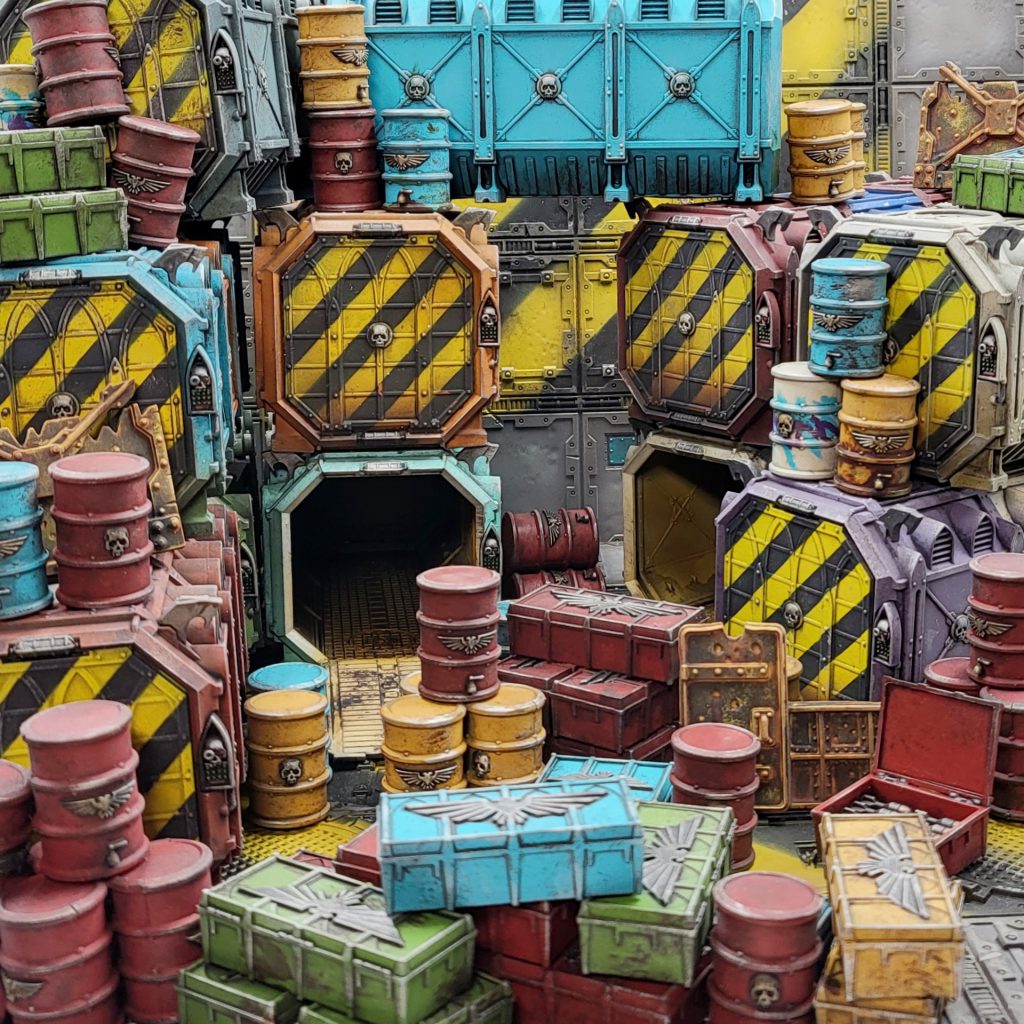
After a short hiatus, Apocryphas returned with Nexus of Violence — set, appropriately, in the Nexus, Hive Primus’s sorting yard. It’s a fantastic setting for some gang violence, because Munitorum Armoured Containers and plentiful and wonderful, freight is wicked cool, AND Goonhammer already has a guide on how to paint your containers like the handsome one above.
Of course, such yards — and indeed a lot of Necromunda’s logistics — are the domain of House Orlock, who haven’t yet got anything in an Apocrypha.
So, naturally, the new rules are for Cawdor.
Meet the Path of the Prophet, a spicy new path of faith. As with all Paths of Faith, you can either take this tree and its six built-in articles of faith as a whole, or, with arbitrator permission, mix and match from this and the ones in House of Faith.
The Path of the Prophet’s path-specific rule is that, when generating faith dice, you roll an additional D6 for each fighter by which you outnumber your opponent’s crew. Since this is Cawdor, that’s like to mean pretty constant generation bonuses (unless your opponent is also playing Cawdor of course).
Here’s what we think of the articles:
— “Look not upon the Face of the Prophet, lest he Blind you with his Glory!” (5+ threshold): Flipping the facing of enemies can offer some useful charging bonuses, giving your fighters Backstab bonuses and making them harder to land reaction attacks upon. It’s also useful for negating some defensive bonuses based on front-facing arcs, such as Furnace Plates. Optimal usage may prove niche, but this will create some nice opportunities, and if nothing else provides a reliable way to buff a charge. Rating: B
— “By his Word shall you be Redeemed and in his Name shall you Serve!” (8+ threshold): Insanity is possibly the nastiest status effect in the game (unless you count Webbed), so basically anything that gives you an opportunity to turn an enemy Insane is good. Without tactics card shenanigans usage of this is a little trickier than it may first appear: because articles of faith are invoked at the start of a fighter’s activation, to use this you either need to charge, not kill your opponent, and then survive long enough to activate again and use it, or survive a charge and then use it when you activate. Against the ideal targets for Willpower checks (usually brutes, most Goliaths, Ogryns and Death Maidens), it’s going to be tricky to survive that long . Still, excellent, despite the fairly high threshold. Rating: A
— “Look to the Light Of The Prophet!” (3+ threshold): Why is it on a 3+? Why is there no downside for failing (to be fair, an issue across this tree)? We’ll never know, but what we do know is that this is extremely good. Consider not only that it lets you set up a shooting line in the Ash Wastes — the new Pitch Black rules also lean on visibility, so you can effectively give your gang temporary Wide Eye in a huge bubble. Yes, opponents can turn it against you if they get close enough, but one of Cawdor’s biggest strengths is being able to control the pace of the game through sheer weight of activations. Very powerful. Rating: A+
— “Look not to the counsel of False Masters!” (7+ threshold): Preventing group activations can be a nice finesse play, but the use case will often be a bit niche. Plus, if you enemies are that close they’ll probably have the option of just killing the fighter using this power. Still, it could be clutch if it stops bad-Cool enemies from benefitting from Leading By Example. Rating: C
— “Let those who Fear, Fear Not, and those who Fear Not, Know Fear!” (Threshold 6+): A kind of Uno reverse card, this might be worth the odds of sending a few allies scattering to instantly rally a leader or champion from your gang. It’s also obviously a good option for an isolated fighter, who can cause disruption in a pretty big area. Rating: A
— “Empty are the Hands of the Faithless!” (Threshold 4+): Another pitifully low threshold, with no downside for failing. If you know you’re going to get charged by something packing a nasty weapon (we think Clawghuls are probably the best example here), this effectively provides excellent tankiness. It will also significantly improve your chances of surviving reaction attacks if you whiff a charge, increasing the chance that you can turn your opponent Insane with “By his Word…” in the next activation. Yay, synergy! Again, very strong, arguably stronger than “By his Word…” because it’s easier to pull it off. Rating: A+
Overall, this is an extremely potent list, especially against gangs that want to get up close and personal. Plus, bizarrely, the rules writers seem to have in this instance thrown out their philosophy of most articles of faith having a clear downside for failing the threshold. It’s a disappointing choice, although admittedly a couple of these could be double-edged swords if used poorly. We’re sure Cawdor players will be very happy with this update.
Feast of Heretics
A cannibal road trip set the stage for more Corpse Grinder goodies in Feast of Heretics, which added CGC crews, dubbed Road-Initiates, as well as a smörgåsbord of unique vehicle items for everyone’s (least) favourite Underhive cannibals. We were surprised to see CGC get more Apocrypha love before Orlocks or Van Saar get… any… but crews are a helpful addition for every gang.
Road-Initiates aren’t much to write home about. At 35 credits apiece, they have mildly worse headstats than the same-priced Orlock Iron Riders, and nothing else going on. Compared to regular CGC Initiates, this seems positively lacklustre, but that’s probably more to do with how stunningly good regular CGC Initiates are. For 15 creds over a Scum Racer, you’re getting two points of Cool, one point of Willpower and the benefit of the model counting as an Initiate for the purposes of gang composition — probably, but not always, worth it.
The real juice is down in the vehicle updates, with the addition of Refrigerated Containers, a new cargo load for Ridgehaulers; the Meat Grinder body upgrade; and two new bits of vehicle wargear — Feast Table and Grisly Trophies. All are exclusive to CGC.
— Refrigerated Container (45 credits): As well as offering two Weapon Hardpoints up top, the Refrigerated Container has the Mobile Feast rule, allowing friendly CGC fights within 1″ of the container to make a Gorge (Double) action, removing either a flesh wound or lost wound on a 3+. This makes it effectively likely a multi-use version of the updated Medicae skill, although needing to spend a whole turn near the container weakens it substantially. We can see this being used more for making a gun-toting CGC fighter already on the container extremely hard to kill, but it might also help this close-range focused gang hunker down effectively in some situations.
— Meat Grinder (20 credits): A -2 Initiative debuff to fighters being run over is huge — substantially increasingly your chance of being able to run over high-initiative fighters, and effectively guaranteeing hits against the likes of Ironhead Squats (most of whom would automatically fail an Initiative check that would be on a 7+). Add in the low price, extra AP, AND the fact that this can apparently be combined with a ram and it looks like the CGC close-up shenanigans are better than ever, baby! (Cries in every other gang.)
— Feast Table (60 credits): A 9″ Cool check re-roll bubble is quite potent, although CGC cool is already decent gang-wide. 60 creds seems a bit pricey, but if you want to cluster lots of Initiates in a vehicle while the big boys run off in search of some lunch, this might pay off.
— Grisly Trophies (45 credits): Forcing would-be attackers to pass Willpower checks is arguably CGC’s greatest strength, and now you can have it on a vehicle — but only against Close Combat attacks. It’s a pretty high price to pay for that kind of tankiness, so we see this as a fairly situational buy (obviously it’ll be at its best against an Ogryn or Goliath boarding party).
Blood, Ash and Gunshine
Orlock Crew Legendary Names
This is a new category of legendary names, the additional sort-of-skills which Orlocks can access as their unique House mechanic. Categorised as ‘Incredible Drives’, these exploits can definitely give some added utility to your crew members. They really are, functionally, a new skill tree open to Orlock Iron Riders only. Unlike the legendary names open to other fighters, which have a lower XP cost to accompany their more minor, or drawback-including, effects, the Incredible Drives are bought in exactly the same manner as Primary Skills. So they cost the same XP as skills (boo). Be not downhearted, their effects are strong (hurrah). But, they are almost all once-per-battle bonuses (boo).
- As an Arbitrator I wish the wording were a little more exact here, the text says “Whenever an Iron Rider spends experience to acquire a Primary Skill, they may instead acquire an Orlock Crew Legendary Name”. We take that to mean you can spend 6XP to roll for one of these six options, or spend 9XP to pick one. We would also apply the same Gang Rating adjustment as for a Primary Skill. Seems perfectly straightforward, but equally we are sure that someone is going to come forward and try and argue the toss in some fashion.
So without further ado, let’s explore these new skills:
- Roadkill. For my money the strongest and fun-est option on the list. Once per battle, for the duration of their activation, fighters can only pass the Initiative test to avoid being run over on a natural 6. For context, that Initiative test is usually at +1 Initiative for Standing fighters, base Initiative for Prone fighters, and a natural 6, just as with Roadkill, for Seriously Injured fighters. So the skill is dramatically increasing your odds of landing hits via running enemies over, unless you were fighting certain Van Saar, Ogryn or Squat gangs anyway, in which case it’s still situationally a significant improvement. So great, it’s easier to run people over, but what does running a fighter over do? See p109 of the rulebook. It inflicts a hit (also inflicting Pinning) based on the Movement Characteristic of the vehicle. If your vehicle has Movement 10″ or more, that is a S9, AP-3, D3 hit! Let’s look into the Book of the Outlands. An 80-credit Orlock Outrider quad has Movement 9″. It can take a Nitro Burner for 15 credits more. It is now able, once per game, to reliably inflict those lascannon-strength hits on your enemies, if it can close with them. First, note just how reliable that damage is – the victims’ attempts to roll a 6 to save is equivalent to you making a 2+ hit roll, then you just need to worry about Wounding, which will also frequently be a 2+. AP and Damage will give you a high chance of taking out all but the toughest targets. Even better, think how easy this is to execute against multiple enemies in a single activation. An Outrider quad is Agile, meaning it can make 2 turns of up to 90 degrees during its upgraded 10″ move. Of course, Move is a Simple action, so you could do it twice. You could literally drive over a couple enemies, probably inflicting those meaty hits on them, then drive back over any survivors again as your second action. Brutal. Rating: A, outstanding moves.
- Genghis Cohen: This really makes me note how nice a simple cheap Outrider is for trying to run over enemies even without this skill. Some gangs have high Initiative so will no-sell it a lot of the time. But my Enforcers, Goliaths, and my own Orlocks, for example, usually have Initiative 4+. That’s not enough to make me feel safe when an enemy vehicle is moving at me like a lascannon bolt! The Ash Wastes are a dangerous place for non-vehicle fighters.
- Big Rig Boss. Once per battle, if your vehicle Toughness is at least 6, the crew can auto-pass a Loss of Control test. Most big vehicles will have tried to mitigate their Handling with upgrades in some way, and this skill is just letting you avoid the risk one time. It would be better if you could ignore the first time you failed the test, in fact you need to decide whether to burn your one chance before you roll the dice. Rating: C
- Cinderak City Drift. Once per battle, make a free Drift action during your activation. To remind everyone, that little-used action is to move up to half your Movement, in a straight line drawn from your side arc. So potentially a very useful bit of maneuvering. Not sure that is worth it as a once-per-battle ability, especially since there is a risk, you have to take a Control test (at +1 Handling, at least) immediately afterwards. So only really worth considering for vehicles with good Handling. But overall, quite niche. Rating: C
- Stunt Driver. The first time per battle you would Roll as a result of a failed Control test, don’t get Wrecked; lose 1 Hull Point instead (you still move your vehicle as per the dice). This is awesome for bigger vehicles which are generally very hard to destroy via actual hits and Hull Point damage; losing control and rolling is often their biggest risk. It’s interesting that this seems far better than Big Rig Boss; in most situations, that 1/6 risk of Rolling is the real terror of a control test, not the movement or risk of stalling out. Rating: B+, provided your crew is driving a really big vehicle.
- Wheels of Pain. Whenever a fighter ends their activation on this vehicle and not on a transport area, they suffer a S3 hit which does not pin them. Yawn. Not many opponents are going to jump fighters onto your vehicles, as cinematic as it is. The kind of fighters that will board your vehicles (usually to tear into them with heavy duty melee weapons) are unlikely to be scared off by that S3 hit. Rating: D
- Duke of the Road. Once per battle, after completing a Ram (Double) action, the vehicle can take the Fire All (Basic) action, targeting the vehicle it just rammed. While slightly situational – you have to ram something, both survive, and then have the right weapons to want to fire at it – this is at least an action economy skill. Not sure it is worthwhile, but it sure is cool and if it does come off you will feel terrific. Rating: B
So some interesting options there, with guided missile fast vehicles using Roadkill, and unrollable (the first time) heavy vehicles using Stunt Driver the big stand-outs. What makes this an optional sideboard, rather than a straight boost to Orlock crews, is the fact these Legendary Names cost the same as other Primary skills. Even the best ones are facing some stiff competition from the better Shooting skills. But hey, they are cool as hell.
Wild Snake Vat
This is an Orlock-exclusive Cargo Load for a Ridge Hauler. Basically, fighters within 1″ can Take a Swig (Basic Action) to remove a flesh wound, and get Intoxicated (negative to BS, positive to Cool, you can accumulate up to 3 Intoxicated markers which strengthen these effects). Additionally, if weapons hit the load, there is a chance, scaled with Strength of the hit, to place a 5″ blast marker over the point on the load closest to the attacker. This marker Intoxicates models under it, or, if the weapon had the Blaze trait, inflicts S4, AP-1 hits. In both cases, fighters under the marker can take an Initiative test to avoid this.
Frankly, we’re not impressed. We have previously discussed how important action economy is in Necromunda, and few fighters will want to give up their action for the Intoxicated effects. Maybe if they don’t have BS weapons and aren’t in a position to do anything else, but if so, why haven’t you planned something better for them to do than chill out around the alcohol supplies? This is more of a narrative, roleplaying upgrade. Note that it does generate income for the owner each game (if not wrecked) or for their opponent (if it is wrecked). But it doesn’t compare to the other benefits of the standard armoured container or promethium tank cargo loads, which are insanely good.
Genghis Cohen: Well that wraps up an Apocrypha where finally Orlocks, the coolest gang, get something nice! I will certainly try and put it into testing out in the Ash Wastes. The whole concept of the wild snake vat mystifies me though, when you walk by an HGV carrying booze, how exactly do you ‘take a swig’? Do the Necromunda designers think there are taps all over the outside?
Well friends, that’s all for now — although given the m̶o̶n̶t̶h̶l̶y̶ regular landing pattern of Apocryphas, we’d expect another one soon. Plus, several gangs haven’t got anything yet — watch this space! Want to show us your weird Czarn conversion? Got a question about dog orders? Just want to say hi? Drop us a line at Contact@Goonhammer.com.
